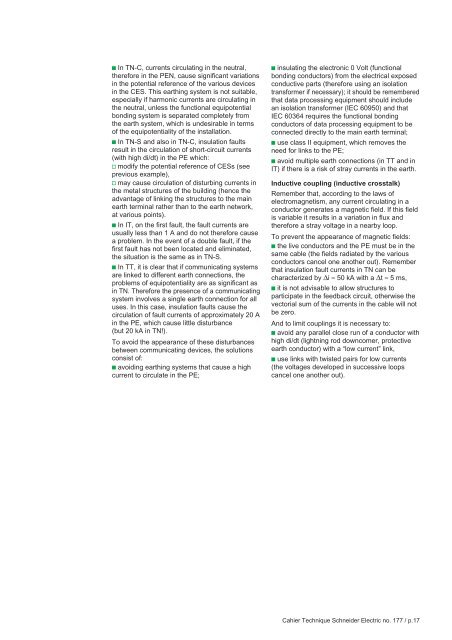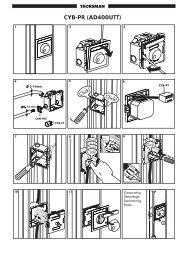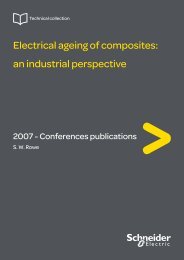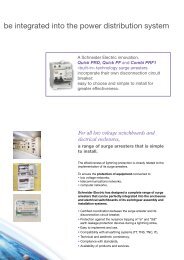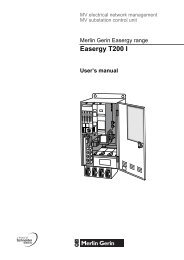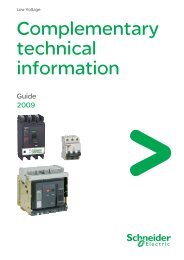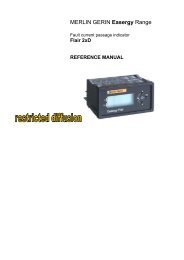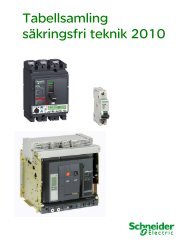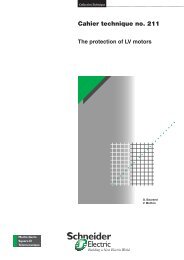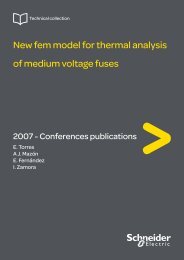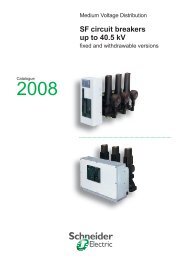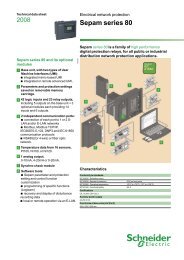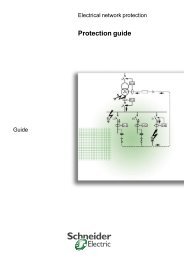Download - Schneider Electric
Download - Schneider Electric
Download - Schneider Electric
- No tags were found...
You also want an ePaper? Increase the reach of your titles
YUMPU automatically turns print PDFs into web optimized ePapers that Google loves.
c In TN-C, currents circulating in the neutral,therefore in the PEN, cause significant variationsin the potential reference of the various devicesin the CES. This earthing system is not suitable,especially if harmonic currents are circulating inthe neutral, unless the functional equipotentialbonding system is separated completely fromthe earth system, which is undesirable in termsof the equipotentiality of the installation.c In TN-S and also in TN-C, insulation faultsresult in the circulation of short-circuit currents(with high di/dt) in the PE which:v modify the potential reference of CESs (seeprevious example),v may cause circulation of disturbing currents inthe metal structures of the building (hence theadvantage of linking the structures to the mainearth terminal rather than to the earth network,at various points).c In IT, on the first fault, the fault currents areusually less than 1 A and do not therefore causea problem. In the event of a double fault, if thefirst fault has not been located and eliminated,the situation is the same as in TN-S.c In TT, it is clear that if communicating systemsare linked to different earth connections, theproblems of equipotentiality are as significant asin TN. Therefore the presence of a communicatingsystem involves a single earth connection for alluses. In this case, insulation faults cause thecirculation of fault currents of approximately 20 Ain the PE, which cause little disturbance(but 20 kA in TN!).To avoid the appearance of these disturbancesbetween communicating devices, the solutionsconsist of:c avoiding earthing systems that cause a highcurrent to circulate in the PE;c insulating the electronic 0 Volt (functionalbonding conductors) from the electrical exposedconductive parts (therefore using an isolationtransformer if necessary); it should be rememberedthat data processing equipment should includean isolation transformer (IEC 60950) and thatIEC 60364 requires the functional bondingconductors of data processing equipment to beconnected directly to the main earth terminal;c use class II equipment, which removes theneed for links to the PE;c avoid multiple earth connections (in TT and inIT) if there is a risk of stray currents in the earth.Inductive coupling (inductive crosstalk)Remember that, according to the laws ofelectromagnetism, any current circulating in aconductor generates a magnetic field. If this fieldis variable it results in a variation in flux andtherefore a stray voltage in a nearby loop.To prevent the appearance of magnetic fields:c the live conductors and the PE must be in thesame cable (the fields radiated by the variousconductors cancel one another out). Rememberthat insulation fault currents in TN can becharacterized by ∆i ≈ 50 kA with a ∆t ≈ 5 ms,c it is not advisable to allow structures toparticipate in the feedback circuit, otherwise thevectorial sum of the currents in the cable will notbe zero.And to limit couplings it is necessary to:c avoid any parallel close run of a conductor withhigh di/dt (lightning rod downcomer, protectiveearth conductor) with a “low current” link,c use links with twisted pairs for low currents(the voltages developed in successive loopscancel one another out).Cahier Technique <strong>Schneider</strong> <strong>Electric</strong> no. 177 / p.17


